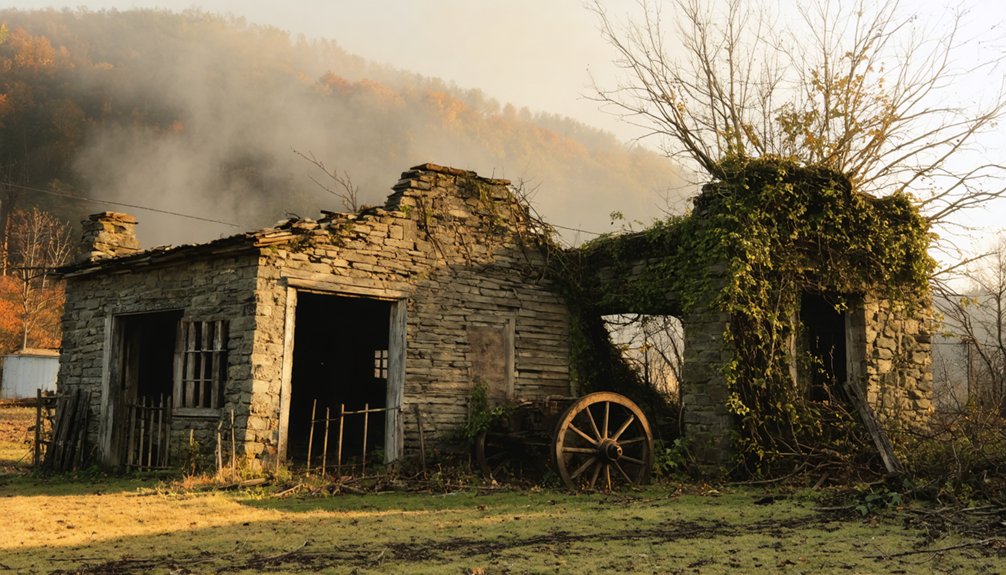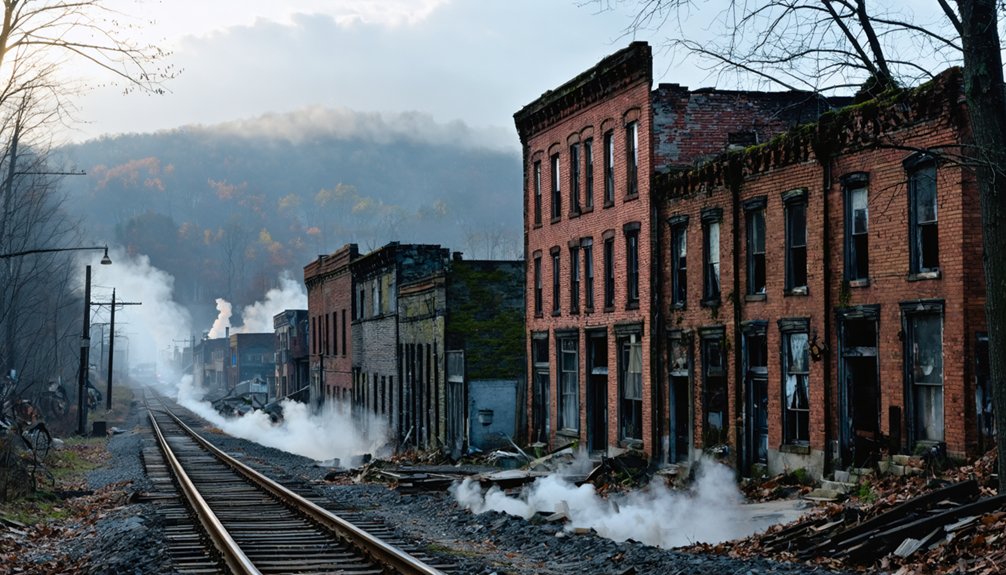You’ll find America’s three best-preserved Civil War ghost towns in Harpers Ferry, Andersonville, and Port Royal. Harpers Ferry’s abandoned federal armory showcases industrial ruins where John Brown’s raid sparked conflict. Andersonville’s prison grounds with original stockade markers reveal the war’s human toll. Port Royal’s untouched plantation structures stand as monuments to naval strategy that freed 10,000 enslaved people. Each site offers a haunting glimpse into the transformation of American society during wartime.
Key Takeaways
- Harpers Ferry represents a well-preserved Civil War ghost town with its industrial ruins and strategic significance at two rivers.
- Andersonville showcases intact prison boundaries, cemetery, and structures depicting Civil War-era imprisonment and suffering.
- Port Royal contains preserved 19th-century buildings that create a time capsule of Southern culture transformed by Union occupation.
- All three locations feature original structures, interpretive markers, and physical remnants of Civil War devastation.
- These ghost towns offer visitors authentic glimpses into Civil War life through meticulously maintained historical landscapes.
Harpers Ferry: Where Industry and Conflict Collided
Nestled at the strategic confluence of the Potomac and Shenandoah Rivers, Harpers Ferry stands as a haunting memorial to the Civil War’s devastating impact on America’s industrial landscape.
As you walk its preserved streets, you’ll witness the remnants of a federal armory that produced 15,000 muskets before Union forces burned it to prevent Confederate capture. This industrial significance vanished in 1861, never to recover.
The town changed hands eight times during the war, including the dramatic 1862 surrender of 12,000 Union troops to Stonewall Jackson. Lieutenant Roger Jones heroically set fire to the arsenal on April 18, 1861, to prevent the valuable weapons from falling into Confederate hands.
Like pawns on a chessboard, Harpers Ferry’s fate oscillated between Union and Confederate control throughout the bloody conflict.
John Brown’s Fort—the fire engine house where his failed slave rebellion ended—remains the town’s most poignant landmark. The raid claimed Heyward Shepherd, a free black man, as its first casualty when he was shot by Brown’s raiders.
Today, Harpers Ferry’s Civil War legacy lives on through meticulously preserved buildings, interpretive markers, and battle pavilions that tell the story of a once-thriving industrial center destroyed by conflict.
Andersonville: The Preserved Remnants of Civil War Imprisonment
Standing as America’s most notorious Civil War prison, Andersonville reveals the darkest chapter of wartime imprisonment through its preserved grounds and memorial markers.
When you visit today, you’ll walk the same earth where 45,000 Union soldiers once suffered and where nearly 13,000 perished in just 14 months of operation.
Andersonville history comes alive through three key preserved elements:
- The stockade boundary markers tracing the 15-foot high pine log walls that once contained up to 33,000 prisoners
- The National Cemetery where row upon row of graves testify to the devastating prisoner experiences
- The National Prisoner of War Museum contextualizing Andersonville’s horror within America’s broader POW history
What was once the Confederacy’s fifth-largest “city” now stands as a solemn reminder of war’s true cost. Visitors can still observe the location of the infamous “deadline” where prisoners risking to cross it would be shot immediately by guards.
The site, which was established in 1970, focuses on the human cost of war rather than celebrating military heroism.
Two pivotal naval operations transformed Port Royal from a sleepy Southern harbor into an essential Union stronghold that would reshape the South’s wartime experience.
Admiral Du Pont’s brilliant elliptical formation bombarded Forts Walker and Beauregard, securing the finest harbor south of Chesapeake Bay.
You’ll find remnants of Southern elegance abandoned in haste as plantation owners fled, leaving 10,000 enslaved people suddenly free.
This precipitated the groundbreaking Port Royal Experiment, where Northern abolitionists established schools like Penn School on St. Helena Island, offering literacy and citizenship training to freedmen.
The first self-governing all-black community called Mitchelville was established in 1862 on Hilton Head Island as part of this experiment.
Today, the preserved 19th-century structures create an authentic time capsule, surrounded by strategic marshlands that once protected Union positions.
Walking these grounds, you’ll experience the tension between faded Southern aristocracy and the first breaths of freedom that revolutionized American society.
The battle significantly impacted military strategies by transforming Port Royal into a major supply base for the South Atlantic Blockading Squadron.
Frequently Asked Questions
How Did Civilians Survive in These Towns During Military Occupation?
Determined denizens displayed civilian resilience by building bartering networks, creating hidden food caches, and managing resources carefully. You’d survive through community vigilance, coded communications, and constantly adapting to military patrol patterns.
What Preservation Techniques Maintain These Sites Against Weather and Development?
You’ll find earthworks receive regular stabilization, buildings get shoring with period-appropriate materials, while legal protections like National Register listings shield these fragile remnants from both weather’s assault and development’s encroachment.
Are Paranormal Investigations Permitted at These Civil War Locations?
Playing with fire at these sites requires permits. You’ll need special authorization for paranormal investigations, though some locations offer official ghost tours and haunted history events under strict preservation guidelines.
Which Ghost Towns Have Archaeological Digs Still Uncovering Civil War Artifacts?
You’ll find ongoing artifact recovery at Cahawba, Doaksville, and Virginia City, where archaeologists continue unearthing items of historical significance from the Civil War period, revealing untold stories of American conflict.
How Did Post-War Reconstruction Affect These Towns’ Abandonment Timelines?
Paltry policies prolonged painful demise. You’ll find Reconstruction effects accelerated abandonment through 1865-1880, as federal neglect and Economic decline left these communities stranded without infrastructure, capital, or population to sustain themselves.
References
- https://www.mentalfloss.com/geography/american-ghost-towns-can-still-walk-through
- https://en.wikipedia.org/wiki/Wikipedia:WikiProject_Ghost_towns
- https://www.christywanders.com/2024/08/top-ghost-towns-for-history-buffs.html
- https://m.dresshead.com/files/scholarship/Documents/Ghost_Towns_Lost_Cities_Of_The_Old_West_Shire_Usa.pdf
- https://www.geotab.com/ghost-towns/
- https://freepages.rootsweb.com/~gtusa/history/
- https://www.americansky.co.uk/travel-inspiration/top-10-american-civil-war-sites
- https://en.wikipedia.org/wiki/Wikipedia:WikiProject_Ghost_towns/Assessment
- https://www.visittheusa.com/experience/5-us-ghost-towns-you-must-see
- https://www.youtube.com/watch?v=zRfBNdUOgOQ



